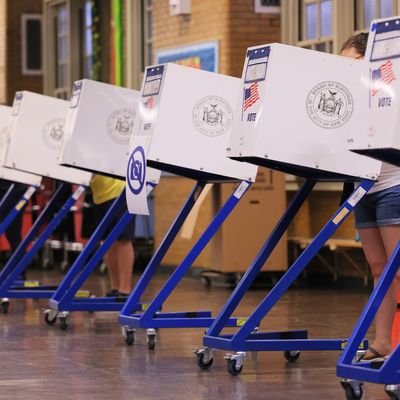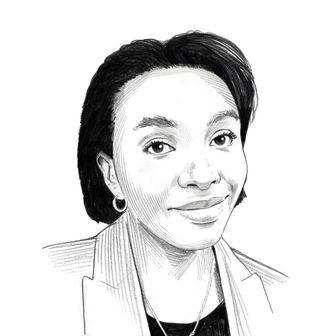
New York’s highest court heard initial arguments Wednesday afternoon on whether Democrats should get another crack at redrawing the state’s congressional lines, a matter with significant implications for control of the House of Representatives come 2025. The case comes on the heels of a drawn-out redistricting process last year, which paved the way for Republicans to flip several seats statewide.
As proceedings kicked off in Buffalo, here’s what we know about the case, and how the court’s eventual decision might affect next year’s elections.
How did we get to this point?
In 2014, New York voters supported a ballot proposal that created an independent redistricting commission, which was tasked with drawing fair maps for the State Legislature and for New York’s congressional delegation. But the partisan panel predictably failed to reach an agreement on the state’s maps following the 2020 Census. This stalemate allowed the majority Democratic Legislature to step in and approve a new map that heavily favored them. Governor Kathy Hochul signed the map into law, but Republicans swiftly challenged it in court, and the case ended up in Steuben County, a Republican-friendly jurisdiction, where Justice Patrick McAllister ruled the map was drawn with political bias. After a series of challenges and appeals, the matter came before the Court of Appeals, which, in a seismic decision, ruled the maps unconstitutional by a 4-3 vote and appointed a neutral special master to redraw the lines prior to the 2022 elections. Those elections then descended into internal upheaval, with some House members drawn into the same districts, and some incumbents rushing to run for new seats entirely. In the end, a more neutral map helped the Republican Party flip four seats held by Democrats — exactly its current margin of control in the House.
So why are we doing this again?
After the 2022 elections, a group of New York voters that has the backing of Democratic leadership argued that the Court of Appeals never specified whether the special master’s map was simply an interim solution or whether it was intended to stay in place until 2030, when the next redistricting cycle gets going. The group also claims that the independent redistricting commission did not fulfill its constitutional duty when it failed to agree upon a map and allowed the Legislature to intervene.
An Albany appellate court heard arguments in Hoffman v. New York State Independent Redistricting Commission back in July and ruled in favor of the plaintiffs, ordering that the commission produce a new map before the 2024 election. That decision was challenged by Republicans, forcing the matter to the Court of Appeals (which is the confusing name of New York’s highest court). Republican opponents see the case as a weak attempt to try to overturn the previous year’s losses through judicial means.
Do we have a sense of how the court might rule?
The current makeup of the court appears more favorable to Democrats than it did last time around. As in 2022, all of the judges currently serving on the panel were appointed by Democratic governors, either former governor Andrew Cuomo or Hochul. Such uniformity did not help Democrats then, but there has been recent turnover on the court. Janet DiFiore, who served as chief judge when the initial ruling was handed down, retired last year. Hochul’s attempt to replace DiFiore devolved into a protracted fight over her preferred candidate, Hector LaSalle, who was voted down by Democrats on the State Senate Judiciary Committee. The governor later nominated Rowan Wilson, an associate judge on the court, who was approved by the Legislature without difficulty. Wilson, in his associate role, previously dissented in the court’s decision to throw out the Legislature’s maps.
Last month, another newly appointed judge, Caitlin Halligan, decided to recuse herself from the redistricting case, citing a close personal relationship with an attorney on the case, per the New York Daily News. As a result, Halligan will be replaced temporarily on the court by Dianne Renwick, the presiding judge of the State Supreme Court’s appellate division, first department. Renwick is also a Hochul appointee.
What could this mean for 2024?
In the wake of its substantial losses from last cycle, the Democratic Party has made New York a top target for 2024. Another attempt at redistricting would allow the party a chance to address the many complaints levied at the special master’s maps, including allegations that the redrawn districts diluted the voting power of certain minority communities through the state and New York City in particular. Even the slightest change in favor of the Democratic Party could reverberate through next year, since many of the same congressional seats lost in 2022 are once again up for grabs. The Cook Political Report lists several key races in the state as toss-ups, including the seats held by congressmen Mike Lawler, Anthony D’Esposito, Marc Molinaro, and Brandon Williams. The race to replace the legally troubled congressman George Santos appears even more competitive. CPR’s analysis sees that race as slightly favoring Democrats.
When will the Court of Appeals make a decision?
The court is likely to issue a ruling sometime in December. If the panel intends to rule in favor of redrawing the maps, time is of the essence. The independent redistricting commission is required to hold 12 public hearings across the state and will need to decide upon a map before March 1, 2024, which marks the beginning of ballot petitioning.






























